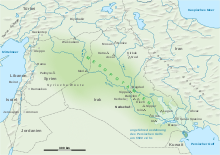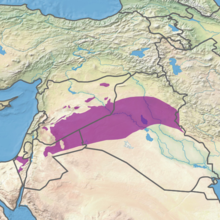Mesopotamia
![]()
This article is about the cultural landscape of the Near East influenced by the river system of the Euphrates and the Tigris. For other meanings, see Mesopotamia.
Mesopotamia or Mesopotamia (Ancient Greek Μεσοποταμία Mesopotamia; Aramaic ܒܬ ܢܗܪܝܢ Beth Nahrin; Arabic بلاد الرافدين, DMG Bilād ar-rāfidain; Persian میان رودان Miyān roodan; Kurdish/Turkish Mezopotamya) refers to the cultural landscape in the Near East shaped by the major river systems of the Euphrates and Tigris.
Together with Anatolia, the Levant in the narrower sense and the Indus Valley, it is one of the important cultural development centres of the Ancient Near East. Together with the Levant, it forms a large part of the so-called Fertile Crescent, where people first settled permanently. City states and kingdoms developed - innovations for mankind with the inventions of writing, the first legal system, the first hymns of mankind, bricks, chariots, beer and ceramics: evolutions in urban development, cultural and technical history. In the south with the Sumerians, interspersed with Godean royal dynasties, the first advanced civilization in human history developed. They were followed by the Akkadians, Babylonians, in the north the kingdom of Mittani, in central Mesopotamia the Assyrians, then the Median kingdom, which conquered the Assyrian empire in a union with the Babylonians. The Medes held a great empire for nearly 200 years before the Persians, the first culture to emerge outside Mesopotamia, gained permanent control of the region. The Persians were followed by the Macedonians, Parthians, Sassanids, Arabs, and finally the Ottomans, whose rule was briefly interrupted in the 17th century by the Persian Safavids.
The land, which varies greatly in terms of water availability, has always offered the people living there very different settlement conditions, which have had a massive influence on historical development.

Mesopotamia within the present state borders
Geography
The natural borders of Mesopotamia are usually considered to be the eastern valley fringes of the Zagros and Taurus mountains, the coastal area of the Persian Gulf, and the incipient Syrian-Arabian desert. The headwaters of the Euphrates and Tigris rivers, on the other hand, do not geographically belong to Mesopotamia. With the end of the Neo-Babylonian Empire, the historical concept of Mesopotamia also came to an end, and from then on it was no longer politically independent. The following epochs with their new political state structures therefore do not fall under the term Mesopotamia from the point of view of Assyriology. Ancient historians, on the other hand, use the term for the following centuries until the end of Late Antiquity, since it was the common name for the region between the Euphrates and the Tigris (see above). When the north of this area came under Roman control around 200 AD, the emperors founded the province of Mesopotamia there, which continued to exist until the 7th century.
Political spheres of influence
Assyria, Babylonia, and Sumer maintained extensive political relations with neighboring countries, some of which were also declared provinces of the Mesopotamian heartlands.

The ecoregion known in English as the Mesopotamian shrub desert. The historical term Mesopotamian Desert is not well defined and overlaps to a large extent with the Syrian Desert.
The successors of Ancient Mesopotamia until the end of Late Antiquity.
The Persian Achaemenids conquered the Middle East and Asia Minor from 550 BC. In Babylon, CyrusII left his proclamation on the Cyros Cylinder in 539 BC, and Mesopotamia became part of the rapidly expanding Persian Empire, which was then in turn conquered by Alexander in 330 BC. After his death, General Seleucus took power in the east of Alexander's empire and founded the Seleucid dynasty. Around 140 BC, most of Mesopotamia then came under the rule of the Iranian-Parthian Arsacids. They made the large city of Seleucia-Ctesiphon on the Tigris their main residence, while Babylon rapidly lost importance after the conquest by the Parthians and Seleucid-Parthian wars in the following period.
The Euphrates marked the border to the Imperium Romanum for a long time, until the Romans under Emperor Septimius Severus annexed northern Mesopotamia around 200 AD and ruled over it for more than four centuries. A few years later, the kings from the Arsacid family were overthrown by the Persian Sassanids, who, however, continued to reside in Ctesiphon. Although they themselves were Zoroastrians, Christianity spread under the Sassanids in Mesopotamia, which was also an important center of Judaism in late antiquity. With the fall of the Sassanid Empire in the course of Arab expansion around 640 AD, the pre-Islamic history of Mesopotamia came to an end.
Questions and Answers
Q: What is Mesopotamia?
A: Mesopotamia is a historical region in the Middle East that included most of today's Iraq, and parts of modern-day Iran, Syria, and Turkey. The name refers to the Tigris and Euphrates rivers which ran through the area.
Q: What was the ancient writing called used by Sumerians?
A: The ancient writing used by Sumerians was called cuneiform. It was first used around 3000 BC.
Q: Who were some important historical leaders from Mesopotamia?
A: Some of the important historical leaders from Mesopotamia were Ur-Nammu (king of Ur), Sargon of Akkad (the founder of the Akkadian kingdom), Hammurabi (who established the Old Babylonian state), and Tiglath-Pileser I (who started the Assyrian Empire).
Q: What advances in technology did Sumerians make?
A: Sumerians made many advances in technology such as irrigation, trade by river, flood control, agriculture, domestication of animals/livestock, and use of a potter's wheel for making clay pots. They also adapted it for transport.
Q: Where is Mesopotamia located geographically?
A: Geographically speaking, Mesopotamia is bounded in the northeast by the Zagros Mountains and in the southeast by the Arabian Plateau.
Q: What makes Mesopotamia significant historically?
A:Mesopotamia is often referred to as "the cradle of civilization" due to its significance historically; it was where cuneiform writing originated around 3000 BC with Sumerians as well as where Babylon likely became one of earliest cities built by settled people who also invented wheel for pottery making and transportation purposes.
Search within the encyclopedia